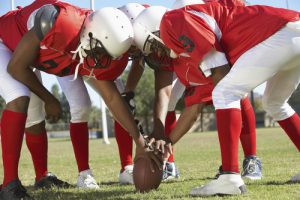
If you’re an NFL fan, you’re probably very familiar with hamstring injuries. Hamstring injuries, and hamstring strains in particular, are the most common football injury. On average, they occur over 172 times every season, and are increasing every year. This season alone, dozens of players from almost every team have gone down for weeks with hamstring injuries: the Cardinals’ DeAndre Hopkins, Bengal’s Chris Evans, Titans’ Julio Jones, Giant’s Sterling Shepard, Eagles’ Miles Sanders, and the Falcons’ Julio Jones, just to name a few.
What Are Hamstring Injuries?
The hamstring is comprised of three muscles: the biceps femoris, the semitendinosus, and the semimembranosus. When you experience a hamstring injury, you have an injury to one or more of these muscles. Hamstring injuries are rated by three grades: 1, 2, and 3. A grade 1 injury is referred to as a hamstring pull or strain. You will feel pain with movement, but still be able to walk. A grade 2 hamstring strain is more serious. You may limp while walking and feel and intense pain in your leg. A grade 3 injury is likely a tear. This is a severe injury, marked by intense pain, swelling, and inability to walk. Most NFL injuries are a grade 1 or 2.
What Causes Hamstring Injuries?
There are 5 proven risk factors for hamstring injuries: tightness in hamstrings, not enough warm up time before physical activity, past injuries, tired muscles, and imbalance in muscular strength between the hamstring muscles and the quadriceps.
Unfortunately, football players are especially vulnerable to each of these risk factors. Why? By nature, football is very stop-and-start, requiring long periods of inactivity before rapid bursts of movement and changes in direction. This style of play, of standing still and then sprinting, puts extreme stress on the hamstring. Plus, many players have preexisting injuries, go into the season out of shape, spend a lot of time on the bench, or are tired in between games, which all heightens the risk of injury.
Recovering From A Hamstring Injury
FOX Sports recently published an article investigating the rate of hamstring injuries during football season. Their data found that following a few weeks of rest, athletes never regained their full ability. On average, players experienced “a 34% decrease in SNAP percentage in their first game back, a 24% in the second game back, and 20% by the third game back. After 4-5 games, it levels off to an 11.9% decrease in SNAP percentage for the rest of the season.” In short: if you get a hamstring injury… better luck next season!
So, why is this the case? It’s because real recovery takes time! Even minor hamstring injuries call for at least 3 weeks off. However, teams are desperate to get their players back on the field, and rush the recovery and healing process. This is why 15.5% of NFL players re-injure themselves after a hamstring injury during the same season, and have a 24% chance of getting a different injury!
Preventing Hamstring Injuries
Hamstring injuries are common in all sports, but are very preventable. A study conducted in 1999 found that regular stretching reduces the rate of hamstring injuries by 16%. In addition, strength training and cross-training are proven to significantly reduce the risk of hamstring injuries. Always warming up before exercise can also prevent hamstring injuries for any type of athlete. Properly hydrating, eating well, and getting plenty of rest is hugely important as well, as fatigue can increase the risk of injury.
If you or someone you love has suffered a sports injury in the Louisville, Kentucky-area, board certified sports medicine physician Dr. Stacie Grossfeld at Orthopaedic Specialists PLLC can help. Orthopaedic Specialists PLLC is accepting new patients, and same day appointments are available. For additional information or to schedule an appointment, please contact Orthopaedic Specialists PLLC today at 502-212-2663.

Recent Comments